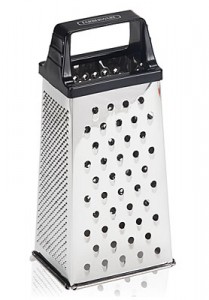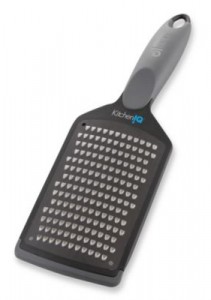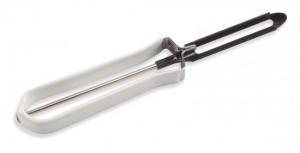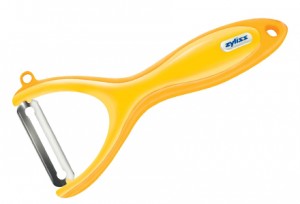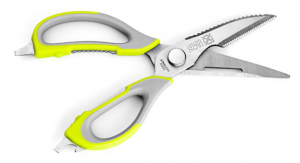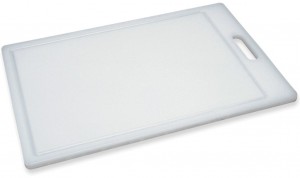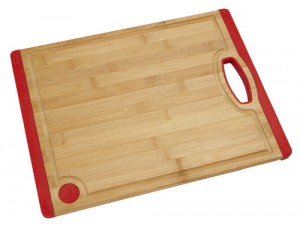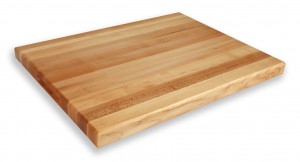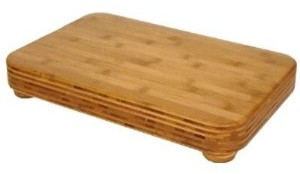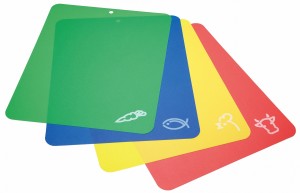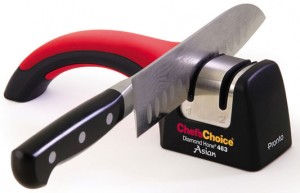We’ve already talked about things to cook your food in. Now it’s time to begin discussing food preparation tools. Today, let’s talk about…
Sharp Things
There are two kinds of sharp things in your kitchen: knives & not-knives. The word knife is pretty self-explanatory. I think we all know what knives are. Not-knives encompass a wide variety of things you can use to cut things up that aren’t knives; graters, peelers & shears fall in this category. We’ll talk a little about cutting boards & knife sharpeners as well. Good knives can be pricey, so it’s good news that the list you really need is short. Here are the ones I consider necessary for everyone.
A chef’s knife

Close your eyes and think about a chef chopping something up…now think about the knife in the chef’s hand. That’s a chef’s knife. It’s the most versatile knife in your kitchen. They come in several sizes and types, but an 8” or 10” one should do the trick for you. It’s important to get one that feels good in your hand because you two are going to do a lot of prep work together. It’s the knife you’ll use to chop up veggies, slice meat, smash garlic…you name it. As you get used to yours, it’ll feel like an extension of your arm and it’ll feel weird when you use someone else’s knife. It’s also important to find one that has a good, solid grip. Trust me, a knife is not something you want slipping around while you’re chopping.

There are two main types of this kind of knife: a regular chef’s knife and a santoku. A santoku is a Japanese version of a chef’s knife and has a few structural differences from a regular chef’s knife. If you take a look at a chef’s knife, you’ll see that the blade curves up at the tip to meet the top of the knife. That curve is much less pronounced on a santoku. You can also see little vertical grooves on the santoku’s blade. Allegedly, the grooves are supposed to keep food from sticking from the blade. I don’t know if that’s actually true, but they do look cool. I have both and tend to use my santoku more than my standard chef’s knife, but it’s a totally subjective thing. It’s much more important to get the one that feels best in your hand and fits your budget. Now, about that budget… Knives are not a place to skimp. That being said, you don’t necessarily need to spend a fortune on your knives. I would suggest spending at least $20 to $30 for a decent chef’s knife.
A paring knife
Now it’s time to imagine your Great Aunt Tilly peeling potatoes with a little knife. That one is a paring knife.
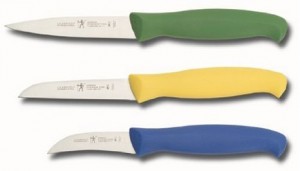
They generally have a thin 3” to 4” blade that usually tapers to a point. They’re all used for general utility work in the kitchen when a bigger knife just won’t do. They have a lot of different blade shapes, but they mostly do the same things. I also like my utility knife, which is a slightly bigger paring knife.

I use mine like I would use a paring knife. It’s a little longer than a paring knife, 4” to 6” long, and just feels better in my hand than the paring knives I own. Whichever one you choose for yourself, a perfectly good one shouldn’t cost more than $10 for a regular paring knife and $20 for the utility knife.
A bread knife
I can hear you now: “I’m not baking any bread! Why do I need a bread knife?” Just because you’re not baking bread (yet!) doesn’t mean you won’t ever buy bread that needs slicing. And a bread knife isn’t just for slicing bread. Bread knives have long, thin blades with deep serrations along the cutting edge. The serrations make it able to cut through bread crusts, both soft and crunchy, without smooshing them. It also makes them perfect for cutting through cake, tomatoes, watermelon, etc. You can get a nice one for about $20.
That’s it for knives…I told you the list was short! Now, on to non-knives!
A grater
A grater has always been the go-to tool for shredding cheese and veggies by hand. There are a couple of different kinds, box graters and paddle graters.
A box grater has anywhere from 3 to 8 sides and each side has holes for different kinds of grating or shredding. It’s probably the kind your grandma has.
A paddle grater is the same idea, but with just one side and one set of holes.
It might seem like a good idea that more sides equals more versatility, but I have to tell you that in a bazillion years of home cooking I’ve never used more than one side of my box grater. Choose for yourself. If you opt for the box grater, make sure it’s fairly heavy duty and won’t slide around while you’re trying to use it. If you go the paddle grater route, it needs to have a comfortable, non-slip handle. You can get either one for less than $15.
A peeler
Technically, you can peel anything with your paring knife. However, a good peeler can make your life a lot easier, especially if you’re partial to mashed potatoes, carrot sticks, apple pie or any other dish that calls for skinless fruits or vegetables. Unless you’re a chef, a peeler does that job much faster and more efficiently than any knife can. Like most things, there are lots of different variations. Here are the two main kinds.
Standard swivel peelers have a hinged blade that’s parallel to the handle and is probably the kind your Great Aunt Tilly uses.
Y peelers have a hinged blade that connects to the arms of a Y-shaped handle. Unlike a swivel peeler, the blade on a Y peeler is perpendicular to the handle.
My peeler is a Y peeler with a ceramic blade. Ceramic is nice for peelers because it stays sharp nearly forever. Its downside is that ceramic can be fragile and prone to breakage if mistreated. Choosing one is a personal decision. All I can tell you is get yourself a nice one and it’ll last you forever. Happily, a nice one won’t cost more than $10.
A pair of shears
Knives are all well and good, but they can be dangerous and require practice to really master. Shears, on the other hand, have virtually no learning curve (you’ve been using them since kindergarten!) and are actually better at accomplishing certain cutting tasks than knives. I rarely cut something with a knife if I can cut it with shears. (A note on the difference between scissors and shears; it’s all in the handle. Scissors have handles that come straight down from the blades and the handles are generally the same size. This makes them useful for either hand. Shears have handles that are noticeably different sizes (a larger one for your fingers and a smaller one for your thumb) and one is bent upward at an angle for more comfortable use. Shears come in right-handed and left-handed versions.) I have scissors and shears stashed in almost every drawer in my kitchen; they’re that important. You don’t need a particularly fancy pair, but you do need a tough pair. They need to be heavy-duty enough to cut through bone (yes, I said bone!). The very best ones have blades that come apart for easy cleaning. You can get a good pair for less than $20.
A cutting board
Your precious new knife’s edge can be damaged as much from cutting on the wrong surface as that surface can be by being cut on by your knife. A cutting board is a buffer zone between the two. Ideally, your cutting board will protect your knife’s edge and help it maintain its sharpness through months of use. There are a lot of opinions on what kind of board is best. The only one that’s universally hated is glass; it’s slippery and really bad for your knives. Plastic, bamboo and wood all have their advantages and disadvantages. Let’s go through them one by one.
Plastic
Pros: Relatively inexpensive. Dishwasher safe for easy cleaning.
Cons: Once a plastic board gets cut marks on it, it’s nearly impossible to get it completely disinfected after use. Also, knife-scarred plastic means plastic is getting in your food. Eww.
Bamboo
Pros: Made from a highly sustainable, renewable resource. Absorbs less liquid than a wooden board, so probably more sanitary. Easy care. Often less expensive than wooden boards of the same size.
Cons: Surface is a bit harder than wooden boards, so may be a little harder on your knife’s edge than wooden boards (jury’s still out on that one).
Wood (usually maple)
Pros: Most traditional cutting surface. Kind to knives and won’t dull them quickly. Won’t scar easily. Makes you feel like a real chef!
Cons: Renewable, but not as renewable as bamboo. Needs periodic oiling for longest life. Can be pricey.
After all that, here’s what I have in my own kitchen. Recently, I got rid of my old plastic boards and bought a lightweight, dishwasher-safe 14”x11” wood composite board with silicone corners (for stability) for $10.
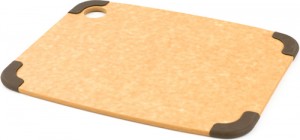 This is my new favorite cutting board.
This is my new favorite cutting board.
At the same time, I splurged on an 18”x12”, 2” thick bamboo board.
(I spent $60 on this board; a similar maple one is over $100.) I haven’t used the new bamboo board yet; I love my composite one that much. I also like color-coded flexible plastic cutting mats if I’m making something with a lot of ingredients.
The color-coding helps prevent cross-contamination (you don’t want raw chicken juice in your freshly chopped veggies…double eww and dangerous to boot) and flexible mats allow you to roll it up and transfer your food directly to the pan. They’re cheap, so when they get scarred you throw them away. A package of 4 is generally less than $10.
With cutting boards, size matters. You need some room to move and anything smaller than 14”x11” is too little to be of much use.
Those items will get you through approximately 99.9% of all your cutting needs. There are a few others that can help make your life in the kitchen a little easier and they’ve landed on the not strictly necessary, but really handy to have list.
A carving knife
Once your family discovers you’re learning to cook, someone is going to ask you to prepare a turkey…or a ham…or a huge roast. And nothing is better for portioning those out than a honking big carving knife. Mine’s about a foot long and could be mistaken for a short sword. I’m not a fan of serrations on carving knives. I feel they just tear the meat instead of slicing it cleanly. Some of them have those cool little grooves in the blade like a santoku…those are just fine. Get one that’s a minimum of 10” long. They come in a huge variety of price points and sometimes they come in a set with a big pointy fork. I wouldn’t bother with the fork unless you love the knife and you’re getting a really good deal on the set. Expect to spend at least $20, maybe more, on one.
A microplane
Sometimes a tool is just too good for just one use. Such is the case with the microplane. When you Google this thing (and I know you will), some of you might think, “Hey, that looks just like the rasp my Uncle Wally uses when he’s woodworking.” Good call! That’s exactly where this thing came from. A chef, who also enjoyed woodworking, took a good look at the rasp he was using on his project and though it would make a super fantastic grater in his kitchen. He was right. A microplane is used when you need to grate something (nutmeg, cheese, garlic, etc.) much more finely than you can with your grater. Get one that feels good in your hand and won’t slip. Remember, each one of those wee tiny blades is wicked sharp and it’s just as easy to grate your fingertips as it is a block of parmesan. They generally cost in the range of $10 to $15.
A pizza cutter
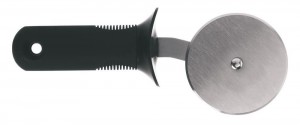
Pizza cutters (and by pizza cutter I mean a circular blade on some sort of handle) look like something you would only use for one thing, but are actually awesome multi-taskers. They’re especially good for cutting flat things that aren’t terribly knife-friendly like various kinds of dough, pita bread for dip, quesadillas, even pizza! Even if you never make your own pizza from scratch, they’re great for that frozen pizza you just bought.
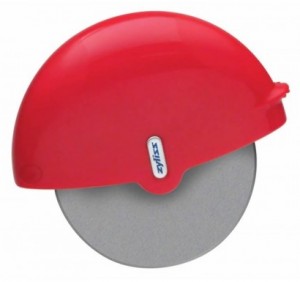
There are several different styles, but the most popular kinds are traditional ones with the handle sticking straight up from the blade and hand wheels where the handle is the housing covering the blade. Choose whichever kinds seems easier for you to use. Just make sure they’re easy to clean (most can go in the dishwasher) and have a blade guard for storage so you don’t cut yourself when getting it out of the drawer. You can get a good one of either type for less than $20.
A knife sharpener
I bet you were surprised by the picture.
You were expecting to see one of these.
This thing isn’t a knife sharpener; it’s called a honing steel. They’re for straightening your already sharp blade.
See, every time you use your knife the sharp edge is bent ever so slightly as a result of coming in contact with your food and your cutting board. The more you use the knife, the more the blade’s sharp edge gets bent. A honing steel literally moves the sharp edge back into place, but doesn’t actually sharpen it. There’s a real skill to using one so that you don’t damage your blades further. So steer clear of the honing steel for the time being. Sharpening can only be accomplished by actually grinding away teeny bits of the blade’s metal, giving it a completely new edge. Most chefs have their blades professionally sharpened a couple of times a year. If you choose to go down this path, expect to pay $5 to $10 per knife. If you choose to get a knife sharpener of your own, please look for well-reviewed ones online and get a good one. The least expensive decent one I’ve seen online is $40.
Now let’s have a few words about knives and knife safety. If you don’t take anything else away from this, please take this: It’s infinitely safer to work with a razor sharp knife than with a dull one. A knife’s blade should slide through your food with very little pressure. If you’re hacking away at something slippery like a tomato or a mango with a dull knife, I can almost guarantee you’re going to cut yourself. Here are some tips for keeping your blades light saber sharp:
- Don’t cut anything but food with your knives! Don’t use them for opening boxes from Amazon (or anybody else), as screwdrivers, as pry bars, etc. Your knives are for food only!
- Don’t put them in the dishwasher! No cutting tool in your kitchen, with the possible exception of your shears or pizza cutter, should ever go in the dishwasher. Spend a few calories and wash them, very carefully, by hand. And be sure to dry them thoroughly immediately after washing. Rusty blades are gross.
- Figure out where you’re going to store them safely. I use a knife block that sits on my counter top for mine and it has a convenient little slot for my shears…nice! There are also knife blocks that fit inside a kitchen drawer. Other chefs swear by using a magnetic strip. Make sure your knives are magnetic before you decide on this…many stainless steel knives and all ceramic ones will not stick to a magnet.
Remember that a knife is a very personal thing. That’s why I would steer clear of boxed sets of knives unless you can hold each one in your hand before you buy them.
Next time…tools for mixing!

